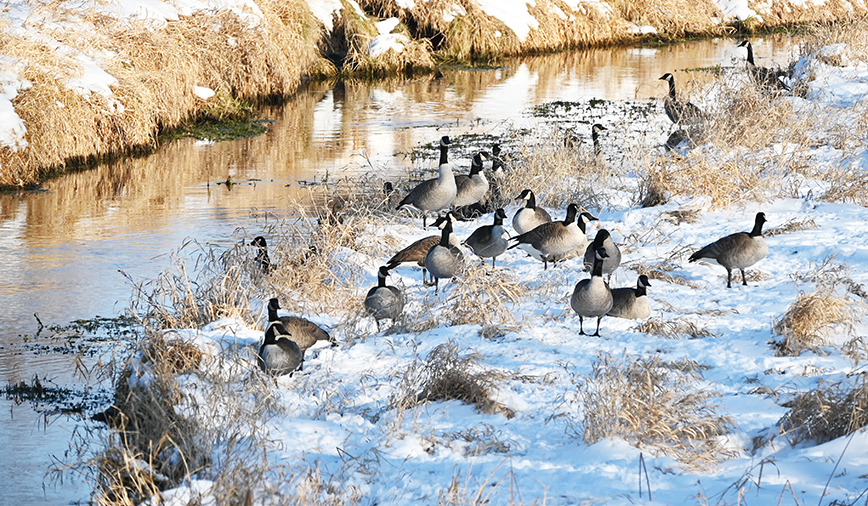Pam’s Perspective
From the…
Pam Otto is the Manager of Natural Programs and Interpretive Services for the St. Charles Park District
March 1, 2013
Driving to work the other day, I saw a familiar sight: hundreds of Canada geese scattered across the frozen athletic fields of James O. Breen Community Park in St. Charles.
Like so many other days this winter, I watched the flocks move slowly along the ground, poking here and there as they browsed on turfgrass. For a brief time I squinted, and could almost picture what it must have been like for early settlers as they watched Midwestern bison graze in a similar manner.
These “tiny bison,” as I’ve come to think of them, are everywhere these days, leaving their assorted marks on snow, turf, pavement and the occasional windshield.
Yep, there’s no escaping these gaggles, attracted as they are to the perfect habitat we’ve created for them.
While most people tend to disparage their presence, I for one look forward to seeing their large flocks. Because that means it’s time for one of my favorite winter games:
One of These Things Is Not Like the Others.
All you need to play is a large group of birds and a pair of sharp eyes—either yours or, if you’re like me and not so gifted, those of a companion. For more advanced players—i.e. those that want to be the first to identify a bird to species—a pair of binoculars or a spotting scope also may be required.
A little background info might be helpful too.
Although for most species it’s not a year-round phenomenon, flocking behavior gives birds certain advantages. So many individuals together increase the group’s chances of spotting sources of food and/or water—as well as potential dangers—than would a single bird flying alone.
Flocks also offer safety. Each creature has a much lower chance of getting plucked by a predator when it remains with a large group as opposed to if it were to strike out on its own.
We tend to think of flocks as being homogenous—and with hundreds of say, geese, strewn before us, it certainly would appear that all the birds are the same species. But closer inspection will often indicate otherwise.
About two weeks ago at Breen Park, a large and clearly not goosy fowl stood head and neck above the rest. This odd bird was a tundra swan, Cygnus columbianus.
Although tundra swans do flock together, this particular individual had for whatever reason gotten separated from its conspecifics. Not to worry though; with hundreds of Canada compatriots close at hand, the swan could rely on its adopted flockmates to alert it to danger, as well as good places to stop for dinner.
Interestingly, the swan eventually sparked another wave of flocking behavior, this one among humans. A crowd of about two dozen ardent birders, most of them members of Kane County Audubon, gathered to watch and photograph the swan, which is considered rare in our area.
This week’s round of One of These Things actually turned out to be Two—two snow geese, Chen caerulescens.
Like Canada geese, snow geese also form large, noisy flocks. But rather than overwintering here, in the midst of suburbia, they tend to congregate in areas where crop fields and large expanses of open water lie in close proximity to each other.
Just as was the case with the tundra swan, there’s no telling what circumstances led the two snow geese to bunk with their Canada goose buddies. But there they were, two white birds, calmly waddling about in a sea of brown and black.
According to the calendar, winter is on the wane. There’s not much time left to play One of These Things; when spring comes, most flocks dissipate as birds adopt the territorial behaviors they need to defend their nesting areas and raise their young.
Take advantage of the time that’s left by visiting open fields with exposed turfgrass or corn stubble, or an open expanse of water along the Fox River. The spring waterfowl migration is underway, so expect some surprises.
And hey, if you happen to see any actual tiny bison—be sure and let me know!

